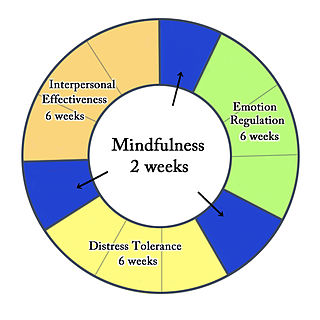Related Research Articles

Psychotherapy is the use of psychological methods, particularly when based on regular personal interaction, to help a person change behavior, increase happiness, and overcome problems. Psychotherapy aims to improve an individual's well-being and mental health, to resolve or mitigate troublesome behaviors, beliefs, compulsions, thoughts, or emotions, and to improve relationships and social skills. Numerous types of psychotherapy have been designed either for individual adults, families, or children and adolescents. Certain types of psychotherapy are considered evidence-based for treating some diagnosed mental disorders; other types have been criticized as pseudoscience.

Psychology is an academic and applied discipline involving the scientific study of human mental functions and behavior. Occasionally, in addition or opposition to employing the scientific method, it also relies on symbolic interpretation and critical analysis, although these traditions have tended to be less pronounced than in other social sciences, such as sociology. Psychologists study phenomena such as perception, cognition, emotion, personality, behavior, and interpersonal relationships. Some, especially depth psychologists, also study the unconscious mind.

Dialectical behavior therapy (DBT) is an evidence-based psychotherapy that began with efforts to treat personality disorders and interpersonal conflicts. Evidence suggests that DBT can be useful in treating mood disorders and suicidal ideation, as well as for changing behavioral patterns such as self-harm and substance use. DBT evolved into a process in which the therapist and client work with acceptance and change-oriented strategies, and ultimately balance and synthesize them—comparable to the philosophical dialectical process of thesis and antithesis followed by synthesis.
Gestalt therapy is a form of psychotherapy that emphasizes personal responsibility and focuses on the individual's experience in the present moment, the therapist–client relationship, the environmental and social contexts of a person's life, and the self-regulating adjustments people make as a result of their overall situation. It was developed by Fritz Perls, Laura Perls and Paul Goodman in the 1940s and 1950s, and was first described in the 1951 book Gestalt Therapy.
In psychology, introjection is the unconscious adoption of the thoughts or personality traits of others. It occurs as a normal part of development, such as a child taking on parental values and attitudes. It can also be a defense mechanism in situations that arouse anxiety.
Object relations theory is a school of thought in psychoanalytic theory centered around theories of stages of ego development. Its concerns include the relation of the psyche to others in childhood and the exploration of relationships between external people, as well as internal images and the relations found in them. Thinkers of the school maintain that the infant's relationship with the mother primarily determines the formation of its personality in adult life. Particularly, attachment is the bedrock of the development of the self or the psychic organization that creates the sense of identity.
Coping refers to conscious strategies used to reduce unpleasant emotions. Coping strategies can be cognitions or behaviours and can be individual or social.

Art therapy is a distinct discipline that incorporates creative methods of expression through visual art media. Art therapy, as a creative arts therapy profession, originated in the fields of art and psychotherapy and may vary in definition.

Emotional reasoning is a cognitive process by which an individual concludes that their emotional reaction proves something is true, despite contrary empirical evidence. Emotional reasoning creates an 'emotional truth', which may be in direct conflict with the inverse 'perceptional truth'. It can create feelings of anxiety, fear, and apprehension in existing stressful situations, and as such, is often associated with or triggered by panic disorder or anxiety disorder. For example, even though a spouse has shown only devotion, a person using emotional reasoning might conclude, "I know my spouse is being unfaithful because I feel jealous."
Ego state therapy is a parts-based psychodynamic approach to treat various behavioural and cognitive problems within a person. It uses techniques that are common in group and family therapy, but with an individual patient, to resolve conflicts that manifest in a "family of self" within a single individual.
The Internal Family Systems Model (IFS) is an integrative approach to individual psychotherapy developed by Richard C. Schwartz in the 1980s. It combines systems thinking with the view that the mind is made up of relatively discrete subpersonalities, each with its own unique viewpoint and qualities. IFS uses family systems theory to understand how these collections of subpersonalities are organized.

William Ronald Dodds Fairbairn FRSE was a Scottish psychiatrist, psychoanalyst and a central figure in the development of the Object Relations Theory of psychoanalysis. He usually used, and was known as and referred to as, "W. Ronald D. Fairbairn".
Cognitive therapy (CT) is a type of psychotherapy developed by American psychiatrist Aaron T. Beck. CT is one therapeutic approach within the larger group of cognitive behavioral therapies (CBT) and was first expounded by Beck in the 1960s. Cognitive therapy is based on the cognitive model, which states that thoughts, feelings and behavior are all connected, and that individuals can move toward overcoming difficulties and meeting their goals by identifying and changing unhelpful or inaccurate thinking, problematic behavior, and distressing emotional responses. This involves the individual working with the therapist to develop skills for testing and changing beliefs, identifying distorted thinking, relating to others in different ways, and changing behaviors. A cognitive case conceptualization is developed by the cognitive therapist as a guide to understand the individual's internal reality, select appropriate interventions and identify areas of distress.
Emotionally focused therapy and emotion-focused therapy (EFT) are a family of related approaches to psychotherapy with individuals, couples, or families. EFT approaches include elements of experiential therapy, systemic therapy, and attachment theory. EFT is usually a short-term treatment. EFT approaches are based on the premise that human emotions are connected to human needs, and therefore emotions have an innately adaptive potential that, if activated and worked through, can help people change problematic emotional states and interpersonal relationships. Emotion-focused therapy for individuals was originally known as process-experiential therapy, and it is still sometimes called by that name.
Transference focused psychotherapy (TFP) is a highly structured, twice-weekly modified psychodynamic treatment based on Otto F. Kernberg's object relations model of borderline personality disorder. It views the individual with borderline personality organization (BPO) as holding unreconciled and contradictory internalized representations of self and significant others that are affectively charged. The defense against these contradictory internalized object relations leads to disturbed relationships with others and with self. The distorted perceptions of self, others, and associated affects are the focus of treatment as they emerge in the relationship with the therapist (transference). The treatment focuses on the integration of split off parts of self and object representations, and the consistent interpretation of these distorted perceptions is considered the mechanism of change.
Schema therapy was developed by Jeffrey E. Young for use in treatment of personality disorders and chronic DSM Axis I disorders, such as when patients fail to respond or relapse after having been through other therapies. Schema therapy is an integrative psychotherapy combining theory and techniques from previously existing therapies, including cognitive behavioral therapy, psychoanalytic object relations theory, attachment theory, and Gestalt therapy.
Dynamic deconstructive psychotherapy (DDP) is a manual-based treatment for borderline personality disorder.
Violet Solomon Oaklander was a child and adolescent therapist known for her method of integrating Gestalt Therapy theory and practice with play therapy.
Imagery Rescripting is an experiential therapeutic technique that uses imagery and imagination to intervene in traumatic memories. The process is guided by a therapist who works with the client to define ways to work with particular traumatic memories, images, or nightmares.
References
- ↑ Schmidt, Shirley Jean (2009). The Developmental Needs Meeting Strategy: An Ego State Therapy for Healing Adults with Childhood Trauma and Attachment Wounds. San Antonio: DNMS Institute. ISBN 978-0-615-27469-0.
- ↑ Siegel, D.J. (1999). The developing mind: Toward a neurobiology of interpersonal experience. New York: Guilford Press. ISBN 978-1-57230-453-6.
- ↑ Introjection
- ↑ Berne, E. (1961). Transactional analysis in psychotherapy, a systematic individual and social psychiatry. New York: Grove Press. ISBN 978-0-345-33836-5.
- ↑ Freud, S. (1923/1961). The ego and the id. In J Strachey (Ed. and Trans.), The standard edition of the complete psychological works of Sigmund Freud (Vol.19). London: Hogarth Press. (Original work published in 1923).
- ↑ Perls, F. S. (1973). The Gestalt approach and eyewitness to therapy. Science and Behavior Books, Inc. ISBN 978-0-553-20540-4.
- ↑ Watkins, J. G., & Watkins, H. H. (1997). Ego states: Theory and therapy. New York: Norton. ISBN 978-0-393-70259-0.
- ↑ Gallese V., Fadiga L., Fogassi L., and Rizzolatti G. (1996). Action recognition in the premotor cortex. Brain 119: 593-609.
- ↑ Gallese V., Eagle M.E., and Migone P. (2007). Intentional attunement: Mirror neurons and the neural underpinnings of interpersonal relations. Journal of the American Psychoanalytic Association, 55: 131-176.
- ↑ Perls, F.S., Hefferline, R.F., & Goodman, P. (1951). Gestalt therapy: Excitement and growth in the human personality. New York: Dell. ISBN 978-3-423-15050-7.
- ↑ Schmidt, S.J. (2004) Developmental Needs Meeting Strategy: A new treatment approach applied to dissociative identity disorder. Journal of Trauma & Dissociation, 5(4), 55-78.
- ↑ Schmidt, S.J., & Hernandez, A. (2007). The Developmental Needs Meeting Strategy: Eight case studies. Traumatology. 13:27-48.